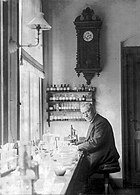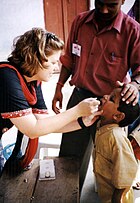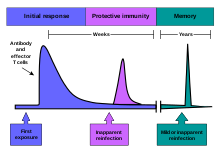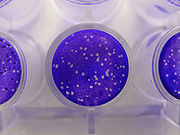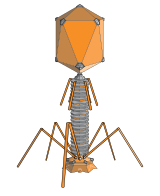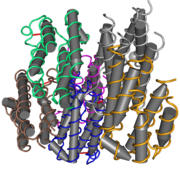Portal:Viruses/Selected miscellany
The following articles are featured as the Selected article at the Viruses Portal. To suggest an article for inclusion, use the suggestions page
Portal:Viruses/Selected miscellany/1
The
DNA had been known since 1869, but in 1952 many scientists believed that proteins carried the information for inheritance. Proteins appeared more complex, while DNA was thought to be an inert molecule used for phosphorus storage. These experiments built on earlier research on transformation in bacteria and helped to confirm that DNA, not protein, was the genetic material. Hershey shared the 1969 Nobel Prize in Physiology or Medicine for the research.
Portal:Viruses/Selected miscellany/2
There are an estimated 1031 viruses on Earth. Although scientific interest in them arose because of the diseases they cause, most viruses are beneficial. They drive evolution by transferring genes across species, play important roles in ecosystems, and are essential to life.
Portal:Viruses/Selected miscellany/3
The
Portal:Viruses/Selected miscellany/4
Vaccination is the most effective method of preventing infectious diseases and can also ameliorate the symptoms of infection. When a sufficiently high proportion of a population has been vaccinated, herd immunity results. Widespread immunity due to mass vaccination is largely responsible for the worldwide eradication of smallpox and the elimination of diseases such as polio from much of the world. Since their inception, vaccination efforts have met with objections on scientific, ethical, political, medical safety and religious grounds, and the World Health Organization considers vaccine hesitancy an important threat to global health.
Portal:Viruses/Selected miscellany/5
A
Prion variants of
Portal:Viruses/Selected miscellany/6
The
Humans and most other vertebrates have more sophisticated defence mechanisms, including the ability to adapt over time to recognise specific pathogens more efficiently. Adaptive immunity creates immunological memory after an initial response to a specific pathogen, leading to an enhanced response to subsequent encounters with that same pathogen. This process of acquired immunity is the basis of vaccination. Viruses and other pathogens can rapidly evolve to evade immune detection, and some viruses, notably HIV, cause the immune system to function less effectively.
Portal:Viruses/Selected miscellany/7
Often slow and labour intensive, traditional methods have been complemented by modern technologies that greatly reduce quantification time, including quantitative polymerase chain reaction, flow cytometry, enzyme-linked immunosorbent assays and tunable resistive pulse sensing.
Portal:Viruses/Selected miscellany/8
Two schemes are in common use. The
The older
Portal:Viruses/Selected miscellany/9
.
Among the most common entities in the biosphere, bacteriophages are ubiquitous in locations populated by bacteria. One of the densest natural sources is sea water, where up to 900 million virions/mL have been found in microbial mats at the surface, and up to 70% of marine bacteria can be infected.
Used as an alternative to
Portal:Viruses/Selected miscellany/10
Most plant viruses are
Portal:Viruses/Selected miscellany/11
being among the most significant viral causes of death.
Infectious pathogens must enter, survive and multiply within the host, and spread to fresh hosts. Relatively few
Portal:Viruses/Selected miscellany/12
Reverse transcription is essential for the replication of retroviruses, allowing them to integrate into the host genome as a
Portal:Viruses/Selected miscellany/13
When a cell is infected by a virus, several virus products, including
Portal:Viruses/Selected miscellany/14
RNA interference is a type of gene silencing that forms an important part of the immune response against viruses and other foreign genetic material in plants and many other eukaryotes. A cell enzyme called Dicer (pictured) cleaves double-stranded RNA molecules found in the cell cytoplasm – such as the genome of an RNA virus or its replication intermediates – into short fragments termed small interfering RNAs (siRNAs). These are separated into single strands and integrated into a large multi-protein RNA-induced silencing complex, where they recognise their complementary messenger RNA (mRNA) molecules and target them for destruction. This prevents the mRNAs acting as a template for translation into proteins, and so inhibits, or silences, the expression of viral genes.
RNA interference allows the entire plant to respond to a virus after a localised encounter, as the siRNAs can transfer between cells via
Portal:Viruses/Selected miscellany/15
A global drive to eradicate poliovirus started in 1988, when there were an estimated 350,000 cases of wild poliovirus infection globally. Two diseases, both caused by viruses, have been eradicated, smallpox in 1980 and rinderpest in 2011. Poliovirus only infects humans. It persists in the environment for a few weeks at room temperature and a few months at 0–8 °C. The oral polio vaccine is inexpensive, highly effective and is predicted to generate lifelong immunity. Reversion of live vaccine strains to virulence has resulted in occasional cases of vaccine-associated polio paralysis.
Two of the three strains of wild-type poliovirus have been eradicated. Annual reported cases of wild poliovirus infection fell to a low of 22 in 2017, but had risen to 176 in 2019. As of 2020, the wild virus remains endemic only in Afghanistan and Pakistan, but vaccine-derived poliovirus is circulating in several countries. A lack of basic health infrastructure and civil war remain significant obstacles to eradication. Some local communities have opposed immunisation campaigns, and vaccination workers have been murdered in Pakistan and Nigeria.
Portal:Viruses/Selected miscellany/16
Bats rarely become ill from viral infections, and rabies is the only viral disease known to kill them. They might be more tolerant of infection than other mammals. Their immune systems differ from those of other mammals in their lack of several inflammasomes, which activate the body's inflammatory response, as well as a dampened stimulator of interferon genes response, which helps to control the host response to pathogens.
Portal:Viruses/Selected miscellany/17
Portal:Viruses/Selected miscellany/17
Portal:Viruses/Selected miscellany/18
Portal:Viruses/Selected miscellany/18
Portal:Viruses/Selected miscellany/19
Portal:Viruses/Selected miscellany/19
Portal:Viruses/Selected miscellany/20
Portal:Viruses/Selected miscellany/20



